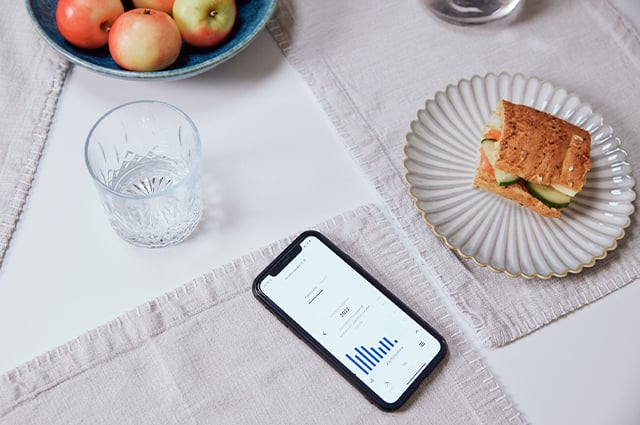The district heating will be renewed in 2024
We will renew our district heating products for consumer, housing company, and business customers at the beginning of next year. The aim of the product renewal is to clarify district heating products and improve the visibility and consistency of pricing. Please see the key changes on this page.
Check out the key changesCheck out frequently asked questions
Changes to district heating and cooling pricing
Customer-specific changes and estimates for heat consumption and payments for the year 2024 have been communicated in the forecast report sent in September. You can also find the forecast report in Oma Helen or Yritys Helen.
By logging in to Oma Helen web or Yritys Helen you can view your property's energy consumption. The service provides comprehensive information about your heat usage, even on an hourly basis, and allows you to easily track when you use the most heat.

The product renewal improves the consistency of district heating pricing
We will renew district heating products and clarify the pricing basis, pricing periods, and publication dates of prices. With the renewal, pricing will be more transparent, and your opportunities to influence district heating charges will improve.
We have taken into account customer feedback received from district heating customers in the renewal – the most visible practical changes are related to the removal of the water flow charge and the improvement of pricing predictability.
The product renewal will come into effect on January 1, 2024.

Changes to cooling energy pricing
The district heating product renewal also affects cooling pricing. The cooling energy price will change as the summer season charge for district heating, which has been the basis for the charge, will no longer be in use. The change to the current cooling energy price is minor.
For more information on changes to cooling energy prices, please see the section below.

You can influence costs with your actions
The product renewal enables even better predictability for heating costs when a fixed basic price is added to an energy price based on the property's consumption. By investing in energy efficiency, you can influence the heating costs of your property.
For more information on changes to basic and energy prices, please see the section below.
What changes does the renewal include?
Heating costs will be easier to monitor in the future, as the price of district heating will consist of a fixed basic price and an energy price, the prices of which will be updated every six months for one year at a time starting from the beginning of 2024.
You can check your new basic price in the forecast reports sent to customers at the beginning of October. The energy prices for 2024 will be published at the end of November.
Energy price – consumers, housing companies and businesses
The energy price is determined by monthly consumption and energy price. The energy price changes every month, and new prices are updated every year on January 1 and July 1. The change replaces the previously used seasonal price updated four times a year.
The energy price is based on the amount of heat energy used and its price. The more the property is heated and the more hot water is used, the more heating energy is consumed. The energy price is calculated by multiplying this consumption by the energy price of the current month.
Basic price – consumers
The basic price replaces the water flow charge, the pricing basis of which has been considered complicated.
In the future, the basic price will be paid according to how much district heating the property consumes on average per year. The property's usage power is based on the average annual consumption of the previous 36 months. For consumer customers whose usage power is over 50 MWh per year, the usage power is based on the highest daily average power.
The basic price will be a monthly charge in the future, and its amount will be reviewed once a year. The review will be made after the heating season, and the updated basic price will come into effect on July 1. There will be no change in the total amount of basic prices in the renewal.
Basic price – housing companies and businesses
The basic price replaces the water flow charge currently in use.
In the future, the amount of the basic price will be determined based on the highest daily average power measured between October 1 and March 31 of the previous 36 months.
The basic price will be a monthly charge in the future, and its amount will be reviewed once a year. The review will be made after the heating season, and the updated basic price will come into effect on July 1, if necessary. There will be no change in the total amount of basic prices in the renewal.
The energy efficiency effect specific to the customer is also taken into account in the basic price, which is determined based on the average temperature of the district heating water returning from the property. If the coefficient is 1, it has no effect on the basic price.
When the current district heating product is renewed, consumer customers will have their own product, Monthly Heating Home, and housing company and business customers will have their own product, Monthly Heating Property.
In the future, the cooling energy price will be determined as follows:
- From January to June, the cooling energy price will be the average of the May-June energy prices for district heating.
- From July to December, the cooling energy price will be the average of the July-September energy prices for district heating.
District heating and cooling will be priced at the same rate, and the cooling energy price will be easily calculated. The cooling energy price is still based on the May-September prices for district heating.
We estimate that the change will have a small lowering effect on the cooling price. However, the price may vary in either direction depending on the development of district heating prices during the summer months.
Schedule for the change
The change will come into effect at the beginning of May 2024, after the end of the current energy price period.
In the transition phase, the first period will be only two months long, May and June, and July-December 2024 will be the first full six-month period.
We will implement the change automatically for all cooling customers, and it does not require any action from our customers.
If you have any questions about the change, please contact us by email at kaukojaahdytys@helen.fi by October 31.
As a result of the renewal, we will introduce product-specific terms and conditions for Monthly heating Home and Monthly heating Property alongside the general terms and conditions for district heating. Minor changes have been made to the general terms and conditions for district heating, mainly due to the renewal of outdated contractual and pricing arrangements (section 14.4 of the terms and conditions).
In 2022, the Energy Industry Association decided to lower the national district heating design temperatures from 115 degrees to 90 degrees. The new terms specify that the temperature of the water returning from the customer to the district heating network may not exceed 65°C, and the section mentioning that the highest inlet temperature of district heating water is usually 115°C has been removed from the terms.
-
The sections concerning contract water flow have been updated. The section concerning additional connection fees has been removed because no additional connection fees will be charged in the future due to the product renewal.
-
The sections concerning heat use control (11.5 e and f) have been clarified.
-
The definition of a consumer has been clarified so that consumer customers are now defined as those whose district heating connection agreement has been made with a personal identification number.
Please see the renewed terms and conditions for more information.
District heating product renewal – frequently asked questions
The aim of the product renewal is to simplify and clarify district heating products and encourage customers to save energy. The product renewal further improves the consistency and equality of district heating pricing. The pricing change included in the product renewal does not increase Helen's revenue, but it is a structural pricing change made based on customer feedback and interviews.
The district heating bill consists of a fixed basic price based on usage power and an energy price. The basic price of the Monthly Heating Property product is also affected by the ability of the property's district heating equipment to cool district heating water. The effect can be either positive or negative. The previously used water flow charge as the basis for the district heating basic price is replaced by usage power, which is reviewed annually.
The product renewal enables a better price outlook when the entire year's energy price list is updated at once. The price updates will come into effect at the beginning of January and July. The price updates will include locked-in 6-month prices and a 6-month price forecast. The price updates will come into effect at the beginning of January and July, and they will be communicated one month in advance, i.e., on November 30 and May 31.
According to customer feedback, seasonal energy prices were considered unclear. Monthly pricing is more cost-effective and encourages our customers to save energy.
You can view your property's energy consumption and usage power by logging into Oma Helen with a web browser. Housing company and business customers can see the information in Yritys Helen. You will see your usage power on the heating bill and also in Oma Helen and Yritys Helen next year.
The usage power will be reviewed annually by the end of May, and the new usage power will come into effect every July. The annual review of district heating usage power does not require any action from the customer. We do not charge an additional connection fee when increasing the usage power.
Determining the usage power based on actual consumption increases the clarity, fairness, and transparency of payment criteria. For example, changes in the building's purpose or habits affect the usage power.
At your request, we will conduct usage power inspections based on one year's consumption adjusted for weather. Therefore, you can request a separate inspection for an energy efficiency measure that you believe will affect district heating consumption after the heating season. The weather adjustment factor aims to balance the discrepancy between different observation periods. Currently, we use a weather correction factor of 1.00 when checking the maximum daily average power and 0.98 when checking the annual average consumption.
In new properties, the usage power is 55% of the design power. The design power is determined based on the technical plans of the property's heating system when the customer joins district heating.
When the product renewal comes into effect (January 1, 2024), in cases where there is no consumption history for three years, the basic prices will remain unchanged. The basis for the basic price will be reviewed to correspond to consumption the following May when consumption history has been accumulated for three years.
With the basic price, we ensure uninterrupted heat supply and ensure that there is enough heat for everyone even during the coldest winter days. The basic price covers the fixed costs of district heating production and transmission, such as investments in production facilities and networks, as well as maintenance.
Monthly Heating Home – frequently asked questions
Usage power is the basis for the basic price. For S, M, and L customers of the Monthly Heating Home product, the usage power is based on the average district heating consumption of the previous three years, and for XL customers, the usage power is the highest daily average power consumption during the November-March period of the last three years. You can see your usage power on the forecast report in Oma Helen.
The energy price accounts for an average of 70% of the total cost for consumers, and the basic price accounts for 30%. In larger properties, the proportion of the usage power charge is slightly smaller.
You can influence your usage power by reducing consumption, for example, by taking care of the heating distribution equipment's condition, the correct setting of the equipment's adjustment curve, and heating consumption habits. District heating energy is used for heating premises and warm water.
Your new basic price will come into effect on January 1, 2024, with the product renewal.
If your basic price level will increase due to the renewal, the new basic price will come into effect on July 1, 2026. The new basic price will be based on the usage power annual review in 2026, so you can affect your new basic price level by reducing district heating consumption at that time.
Usage power describes the average power at which the property has consumed district heating. For a small portion of consumer customers whose usage power is over 50 MWh per year, the usage power is based on the highest daily average power.
The impact of the product renewal on the price of district heating is minor, but the magnitude of the change varies greatly depending on the customer. For most consumer customers, the product renewal means a change of about -25...+25 € (incl. VAT 24%) in monthly total costs for district heating. Therefore, the change on an annual basis is between a €300 increase and a €300 decrease. We will announce the energy prices for 2024 on November 31, 2023.
Yes, they are different terms for the same thing. The same applies to units - for example, an average annual consumption of 50 MWh/a is the same as an annual average power of 5.7 kW.
Monthly Heating Property – frequently asked questions
Usage power is the basis for the basic price. Usage power refers to the customer's highest daily average power consumption during a 36-month measurement period. Only the readings from the heating season, i.e., November-March, are taken into account in the 36-month measurement period. The unit of measurement for usage power is kW (kilowatt). Energy efficiency effect is also taken into account in the basic price of the Monthly Heating Property product. You can see your usage power on the forecast report and also in Business Helen next year.
The energy efficiency effect is part of the basic price of the Monthly Heating Property product. The energy efficiency effect is determined based on the temperature of the district heating water returning from the property (the temperature of the water returning from the property's heating distribution equipment to Helen's district heating network). The energy efficiency effect is a coefficient of the basic price, and the coefficient is between 0.7 and 1.6. You can see your energy efficiency effect on the district heating forecast report in Yritys Helen.
Lowering the district heating return temperature improves the energy efficiency of the district heating system and reduces the production and distribution costs of district heating. Therefore, the return water component makes pricing more cost-effective. We want to encourage our customers to save energy by rewarding them for energy-efficient solutions.
The energy price accounts for an average of 80% of the total cost for housing companies and business customers, and the basic price accounts for 20%. In larger properties, the proportion of the basic price is slightly smaller.
You can influence your usage power by saving energy through heating consumption habits and by taking care of the heating distribution equipment's condition and the correct setting of the equipment's adjustment curve.
District heating energy is used for heating premises and warm water and ventilation.
It is worthwhile to pay attention to energy savings and the timing of consumption to avoid large consumption peaks in district heating consumption. District heating consumption peaks refer to days when district heating consumption is higher than average.
The new basic fee may partially explain the change, but it is not the sole reason for significant changes.
Please note that forecast reports for companies indicate VAT-free payments, unlike the previous year.
The estimated annual consumption of the premises has a significant impact on the forecast of payments. For the 2024 forecast reports, the estimated annual consumption has been updated to reflect the 3-year average, so please also compare the annual energy forecast (MWh) to the previous one.
Cooling – frequently asked questions
As district heating pricing is renewed, the summer season price of district heating, which is the basis for the cooling price, will no longer be used, and the energy prices of district heating will change from seasonal to monthly.
The cooling prices will be published at the same rate as the energy prices of district heating, i.e., twice a year. Therefore, the cooling energy price will change twice a year (January and July) instead of once a year. The cooling price is still paired with the heating price: The January-June energy price of district cooling is the average of the May-June prices of district heating, and the July-December energy price of district cooling is the average of the July-September prices of district heating.
The new pricing basis will come into effect at the beginning of May 2024, after the end of the current energy price period.



